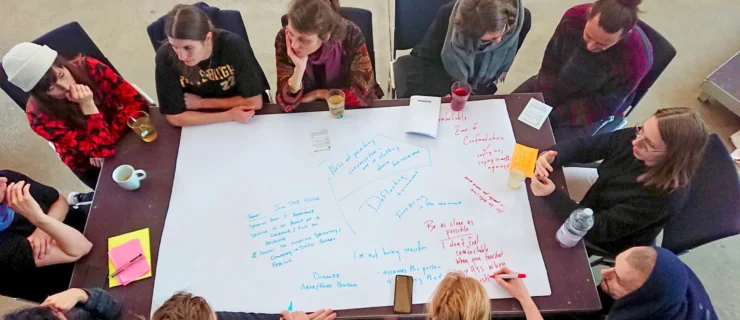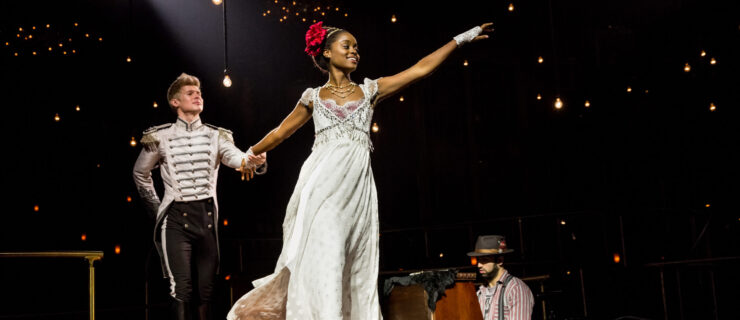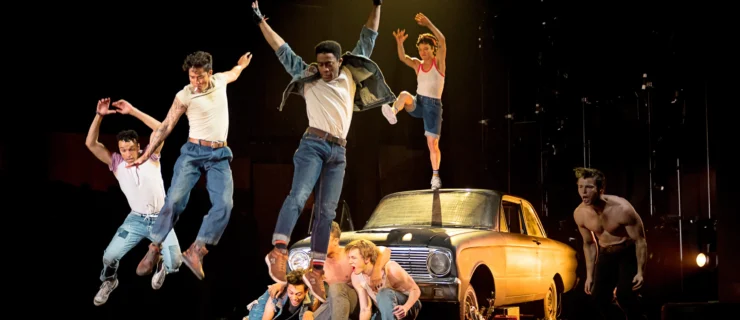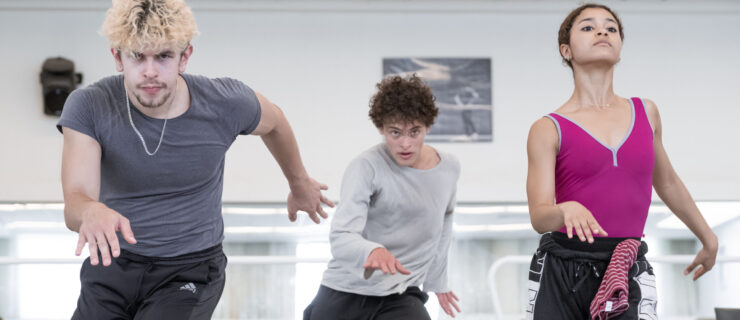The Bolshoi Ballet
“The Flames of Paris”
Bolshoi Theatre, Moscow
Jul 3, 2008
Reviewed by Marc Haegema
Photo by Marc Haegeman at the Bolshoi Theatre.
Maria Alexandrova, Alexander Volchkov, and Denis Savin.
Courtly pageantry in royal Versailles, foot-stomping folk dances, tender lyrical duets, but also thundering cannons, soldiers charging with bayonets, fearless girls brandishing tricolore banners, crowds chanting revolutionary songs, even the infamous guillotine to top it all–The Flames of Paris is a dizzying spectacle one no longer expects to see in ballet. Yet if there is one company that has the potential to bring it off with conviction, then it has to be Moscow’s Bolshoi.
Alexei Ratmansky, artistic director of the Bolshoi Ballet, is fascinated with the ballets from the early Soviet era, which form a neglected chunk of the Bolshoi tradition. He revived the long-lost Shostakovich ballets The Bright Stream (2003) and Bolt (2005). Now, with The Flames of Paris, the ballet that glorified the French Revolution and allegedly was a favorite of Stalin’s, he brought back one of the most successful Soviet creations. Originally choreographed by Vasily Vainonen, with music by Boris Asafiev based on 18th-century French revolutionary songs, The Flames of Paris premiered in 1932 in Leningrad, followed by Moscow, and remained a hit with Russian audiences until the 1960s.
To his credit, Ratmansky approached the ballet from a 21st-century point of view. His The Flames of Paris is not a reconstruction; he prefers to call it “a dialogue with Vainonen.” The initial ideological message is now of course obsolete. Unlike the original ballet, which had the revolutionary crowd as the main hero, Ratmansky rewrote the libretto and focused instead on four individuals caught up in the bloody turmoil of the French Revolution. In 1789, two peasants, Jeanne and Jerome, are forced to join a group of revolutionaries, led by the soldier Philippe from Marseille, marching onto Paris. Jerome was saved from imprisonment by Adeline, an aristocratic girl, who also follows the revolutionaries in disguise. Once in Paris, though, the Revolution is in full swing and freedom is proclaimed. But not without a certain price: in a dramatic denouement Adeline’s true social status is uncovered, and she is brought to the guillotine before the terrified eyes of her friends.
By compacting the original four acts into two and by using a fast-paced, almost cinematographic manner of storytelling, Ratmansky made the production more appealing for present-day audiences. He choreographed mainly from scratch, but incorporated the few surviving passages of Vainonen’s original choreography. Interestingly, the resulting stylistic diversity––from Vainonen’s classical and character dancing to Ratmansky’s neo-classical with a tinge of modern expressivity––gives the ballet extra punch.
The Bolshoi remains true to its name, and the new production, premiered on the New Stage of the Bolshoi Theatre, boasts characteristically grand sets by Ilya Utkin and Evgeny Monakhov, inspired by contemporary engravings. Yelena Markovskaya’s handsome and colorful costumes further provide a historical timeframe.
On opening night, which I was able to attend by kind invitation of the Bolshoi Theatre, Maria Alexandrova gave the leading heroine Jeanne a beating heart and a face. She tackled the demanding choreography with ballerina aplomb. Alexander Volchkov’s Philippe had authority as well as nobility, while Denis Savin made a sincere and touching Jerome. Nina Kaptsova was perhaps a bit pale as Adeline, but there were strong supporting roles, among others Lyudmila Semenyaka, a great ballerina of the previous generation returning to the stage as Queen Marie Antoinette. Overall, the company appeared inspired by the subject and reveled in the many choreographic and dramatic challenges of this production, confirming the Bolshoi’s current strength and flexibility.




